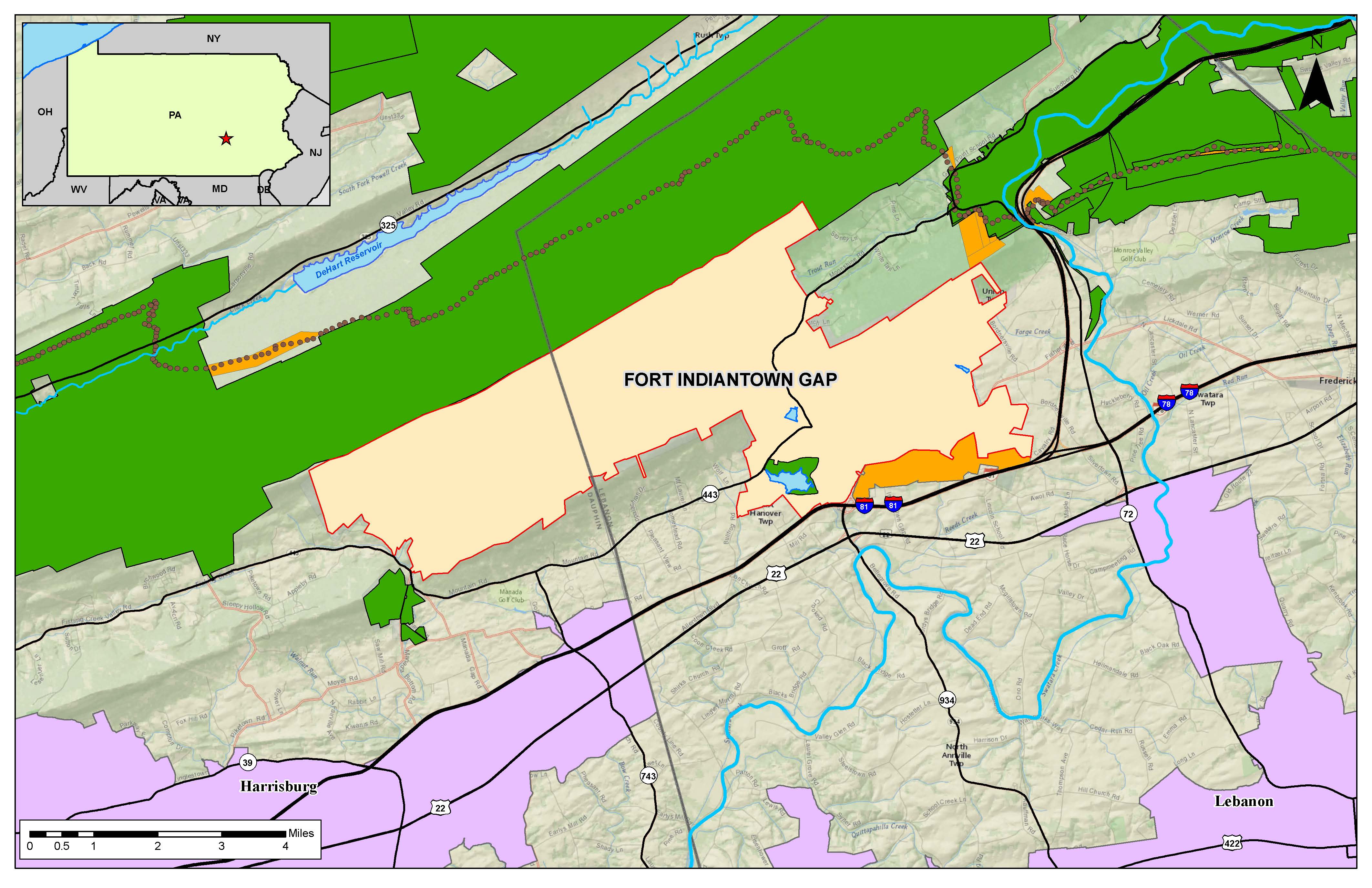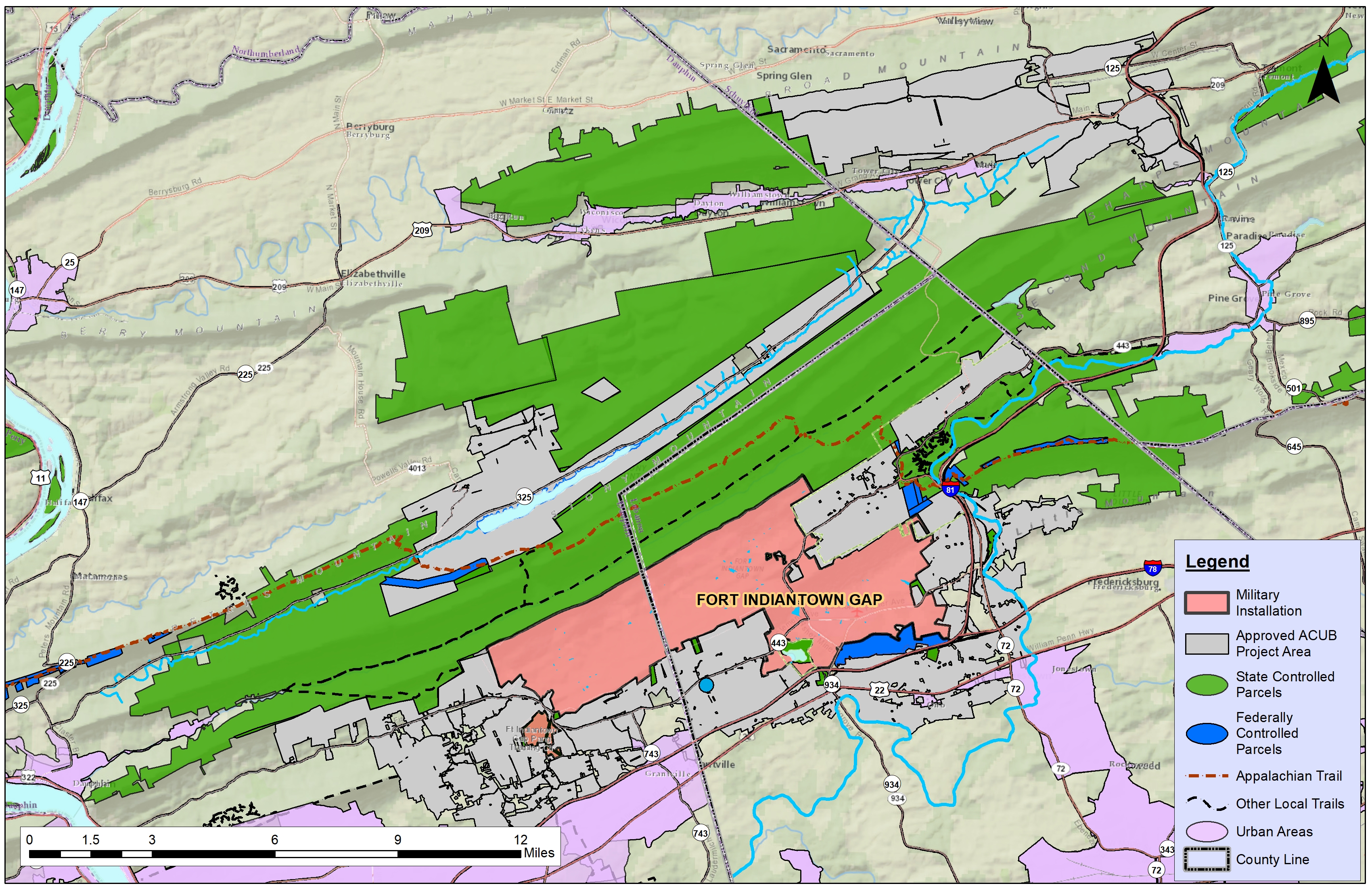Army Compatible Use Buffer (ACUB) Program
Fort Indiantown Gap, like many other military installations in the United States, was originally established in a rural area far from a population center. With population growth, urban sprawl, and other development has come an increasing number of citizen complaints about military training that generates noise, dust, and smoke from weapons, vehicles, and aircraft. Commanders frequently are required to choose between being good neighbors and meeting training requirements. Noise and safety concerns, the presence of cultural and historic resources, and the distribution of endangered species and habitat can often result in training restrictions affecting military readiness.

Fort Indiantown Gap National Guard Training Center (FTIG) is one of the busiest National Guard training sites in the country, with over 100,000 troops training there annually. FTIG is home to the Eastern Army Aviation Training Site (EAATS), whose special -use/restricted airspace has seen a high operational tempo in usage with an average of over 6,500 rotary-wing flight hours and over 7,500-simulator hours as recent as FY22. This makes Muir Army National Guard Airfield at FTIG the Army's second-busiest heliport. FTIG also provides ground training support and hosts multiple military equipment maintenance facilities, artillery exercises, and a live-fire air-to-ground training range.
FTIG's relatively small size (approximately 17,000-acres) and high number of training days each year (over 100,000 personnel training with 688,883 man-days were completed at FTIG in FY22), influences the size of its training footprint, resulting in impacts from training that extend outside the Installation boundary. This increases the possibility of both internal and external training restrictions that can affect mission readiness. External limitations on military training are often referred to as "encroachment". The Army Compatible Use Buffer (ACUB) program is part of the U.S. Army's effort to limit encroachment and maintain a balance among military training requirements, community desires, and environmental protection.
WHAT is ACUB and WHY is it IMPORTANT?
The ACUB program is designed to minimize development that is incompatible with military training activities by utilizing permanent conservation easements, fee-sales, or other interests in land from willing landowners. In the case of conservation easements or similar agreements, the landowner retains ownership and rights to use the land for the purposes specified in the agreement.
Establishing buffer areas around a military installation limits the effects of encroachment on military training and maximizes the amount of available training land inside the installation boundary that can be used to support the installation's mission. These buffer areas also contribute benefits to local recreational, agricultural, forest management, and greenspace uses. There are multiple secondary natural resource and habitat-based benefits to the program. ACUB is a voluntary program; landowners in the approved project area can decide whether they want to participate.
What ACUB is Not?
1. ACUB is
NOT a program to purchase additional land for training or testing at Fort Indiantown Gap. FTIG, The Pennsylvania National Guard, or the US Army do not own, hold the deed, hold an easement, or retain the development rights to properties in the ACUB program. Participating properties are held (via fee-sale, easement, deed restriction, or other method) by a third party.
2. ACUB is
NOT a program to purchase additional land for Fort Indiantown Gap, to acquire additional training or testing areas, or otherwise increase the acreage of FTIG. FTIG cannot use properties encumbered under its ACUB program for training and testing purposes.
3. ACUB is
NOT a mandatory program. The program is
100% voluntary; land owners in the approved ACUB area are
NOT required to participate in this program.
What are the Benefits of ACUB?
Multiple primary and secondary benefits are associated with the ACUB program. These benefits include:
Community Benefits
- Protects working agricultural, forested, and undeveloped lands that benefit the local economy.
- Supports recreational activities such as hiking, hunting, trapping, and fishing.
- Buffers adjacent properties from noise, dust, and smoke generated during military training.
- Partners get financial support for land conservation, including endangered species and habitat protection, and other conservation uses.
Environmental Benefits
-
Protection of Water Resources – Protection of high quality local surface waters, wetlands, the Susquehanna River, and the greater Chesapeake Bay watershed. ACUB projects may contribute to maintiang or enhancing existing riparian habitats.
-
Habitat Conservation – Including the Kittatinny Ridge ecosystem (a global Important Bird Area (IBA)), and high-quality habitat for multiple threatened and endangered species. The Kittatinny Ridge area is the premier raptor migration corridor in the northeastern U.S., one of the leading such sites in the world.
-
Protection of Threatened & Endangered Species – Habitat conservation assists in protecting multiple plant and animal species of concern. Locally, encumbered lands may assist in the Eastern Regal Fritillary butterfly species recovery and repatriation.
-
Protection of Recreation – The Appalachian National Scenic Trail and its viewshed, as well as numerous hiking, fishing, boating, and hunting opportunities in the area.
-
Climate Resilience – Mitigate the effects of climate change on military training, local infrastructure, supply chains, and other installation assets.
Military Benefits
- PANG can train for missions with greater flexibility and fewer restrictions to aviation training and live-fire exercises, including minimization of noise, smoke, and dust complaints.
- Allows full use of large and small-caliber ranges and demolitions facilities, enabling maximum utilization of these facilities and maintaining safety buffers.
- Compatible land use for the military is maintained, while landowners can utilize their land for traditional activities, such as farming, hunting, recreation, etc.
- Improved outreach to local communities and landowners/users.
How Does Fort Indiantown Gap's ACUB Program Work?
As shown on the map below, FTIG has identified an area of focus intended to maximize protection of the three benefit areas discussed above.

Landowners holding real estate in the area identified in light gray above, and potentially interested in participating in the ACUB program, can complete a Landowner Interest form, and submit it (postal or electronic mail) to the contacts below. Alternatively, interested landowners can call the contact phone numbers below to receive a copy of the interest form via postal mail.
As these interest forms are received, they are evaluated and ranked, based on several criteria. A list of ranked landowners/projects is developed for each fiscal year and ACUB funding is applied to priority projects, as it becomes available. FTIG must apply for project funding by the end of each federal fiscal year, to receive money for priority projects for the following fiscal year.
If you are interested in potentially participating in Fort Indiantown Gap's ACUB program, see the Points of Contact below.
PROJECT HIGHLIGHTS
DeHart Reservoir Project
Through a partnership between FTIG, Capital Region Water, the Ward Burton Wildlife Foundation, and The Nature Conservancy, approximately 8,200-acres of land has been protected around the DeHart Reservoir in Dauphin County, a high-quality drinking water source for Harrisburg, an important part of FTIG's aviation training area, and one of the last large areas of unbroken forested habitat in the region. This project includes a conservation easement and forest management planning. This project was fully completed in 2019.
Rausch Creek Project
The Rausch Creek mountaintop areas encompass approximately 3,500-acres in Schuylkill County, Pennsylvania, approximately six miles northeast of FTIG. The intention for the land was to develop these mountaintops for wind energy by placing up to eighty-five 650-foot-tall wind turbines across the ridges. This would have impacted FTIG's aviation training operations in FTIG's Northern aviation Training Area (NTA), a mostly undeveloped landscape that encompasses this project area, by approximately 44% due to the setback distances and compression of available airspace for training. With the ACUB program, FTIG and its partners have been able to successfully encumber the land to protect the airspace and maintain the Pennsylvania Army National Guard's ability to conduct low-level aviation training in the area. This project is slated for up to five phases; the second phase was completed in January 2024.
Preservation of this mountaintop land will allow for darker skies in the area, which benefits wildlife and allows for more effective nighttime operations and training capabilities for aviation personnel. Preventing future development in this area will also aid in creating a larger noise buffer in the NTA so fewer individuals are affected over time. Planning now and protecting the area means an opportunity to lessen any impacts and costs for future training missions.
Current FTIG ACUB Program Status
As of Jan. 2024:
Projects completed: 26.
Acres encumbered: 10,500.
Projects Planned for FY 2024: Rausch Creek Phase 3 and individual projects with partner organizations.
Project Acres Planned for FY 2024: 700
Points of Contact
For additional information about the Fort Indiantown Gap ACUB program, the following contacts are available:
ACUB Program Manager
c/o Mr. Daryl Valley
Fort Indiantown Gap
Bureau of Environmental Management
Building 0-11, Service & Wiley Roads
Annville, PA 17003-5002
email: dvalley@pa.gov
phone: 717-861-2634
The Ward Burton Wildlife Foundation
c/o Mr. Tom Inge
PO Box 519
Halifax, VA 24558
email:
tinge@vt.edu; tom@wardburtonwildlife.org
phone: 434-470-1776